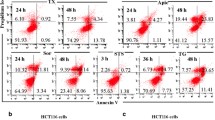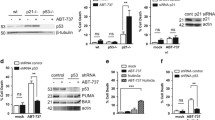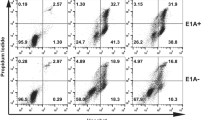Abstract
QM31 represents a new class of cytoprotective agents that inhibit the formation of the apoptosome, the caspase activation complex composed by Apaf-1, cytochrome c, dATP and caspase-9. Here, we analyzed the cellular effects of QM31, as compared to the prototypic caspase inhibitor Z-VAD-fmk. QM31 was as efficient as Z-VAD-fmk in suppressing caspase-3 activation, and conferred a similar cytoprotective effect. In contrast to Z-VAD-fmk, QM31 inhibited the release of cytochrome c from mitochondria, an unforeseen property that may contribute to its pronounced cytoprotective activity. Moreover, QM31 suppressed the Apaf-1-dependent intra-S-phase DNA damage checkpoint. These results suggest that QM31 can interfere with the two known functions of Apaf-1, namely apoptosome assembly/activation and intra-S-phase cell cycle arrest. Moreover, QM31 can inhibit mitochondrial outer membrane permeabilization, an effect that is independent from its action on Apaf-1.




Similar content being viewed by others
Abbreviations
- Apaf-1:
-
Apoptotic protease activating factor 1
- AnnV:
-
Annexin V
- ATM:
-
Ataxia telangiectasia mutated kinase
- ATR:
-
Ataxia telangiectasia and Rad3 related kinase
- CARD:
-
Caspase activation recruitment domain
- CDDP:
-
Cisplatin
- Chk1:
-
Checkpoint kinase 1
- Cyt c :
-
Cytochrome c
- ΔΨm :
-
Mitochondrial transmembrane potential
- DiOC6(3):
-
3,3′ dihexiloxalocarbocyanine iodide
- FBS:
-
Fetal bovine serum
- FITC:
-
Fluorescein isothiocyanate
- IMS:
-
Mitochondrial intermembrane space
- MOMP:
-
Mitochondrial outer membrane permeabilization
- NSCLC:
-
Non-small cell lung cancer
- OM:
-
Mitochondrial outer membrane
- PARCS:
-
Pro-apoptotic protein required for cell survival
- PGA:
-
Poly-l-glutamic acid
- PI:
-
Propidium iodide
- siRNA:
-
Small interfering RNA
- Z-VAD-fmk:
-
Z-Val-Ala-Asp(OMe)-fluoromethylketone
References
Galluzzi L, Brenner C, Morselli E, Touat Z, Kroemer G (2008) Viral control of mitochondrial apoptosis. PLoS Pathog 4:e1000018. doi:10.1371/journal.ppat.1000018
Honda HM, Korge P, Weiss JN (2005) Mitochondria and ischemia/reperfusion injury. Ann N Y Acad Sci 1047:248–258. doi:10.1196/annals.1341.022
Kroemer G, Galluzzi L, Brenner C (2007) Mitochondrial membrane permeabilization in cell death. Physiol Rev 87:99–163. doi:10.1152/physrev.00013.2006
Mattson MP, Kroemer G (2003) Mitochondria in cell death: novel targets for neuroprotection and cardioprotection. Trends Mol Med 9:196–205. doi:10.1016/S1471-4914(03)00046-7
Galluzzi L, Joza N, Tasdemir E et al (2008) No death without life: vital functions of apoptotic effectors. Cell Death Differ 15:1113–1123. doi:10.1038/cdd.2008.28
Garrido C, Kroemer G (2004) Life’s smile, death’s grin: vital functions of apoptosis-executing proteins. Curr Opin Cell Biol 16:639–646. doi:10.1016/j.ceb.2004.09.008
Li P, Nijhawan D, Budihardjo I et al (1997) Cytochrome c and dATP-dependent formation of Apaf-1/caspase-9 complex initiates an apoptotic protease cascade. Cell 91:479–489. doi:10.1016/S0092-8674(00)80434-1
Zou H, Li Y, Liu X, Wang X (1999) An APAF-1.cytochrome c multimeric complex is a functional apoptosome that activates procaspase-9. J Biol Chem 274:11549–11556. doi:10.1074/jbc.274.17.11549
Acehan D, Jiang X, Morgan DG, Heuser JE, Wang X, Akey CW (2002) Three-dimensional structure of the apoptosome: implications for assembly, procaspase-9 binding, and activation. Mol Cell 9:423–432. doi:10.1016/S1097-2765(02)00442-2
Srinivasula SM, Ahmad M, Fernandes-Alnemri T, Alnemri ES (1998) Autoactivation of procaspase-9 by Apaf-1-mediated oligomerization. Mol Cell 1:949–957. doi:10.1016/S1097-2765(00)80095-7
Pan G, Humke EW, Dixit VM (1998) Activation of caspases triggered by cytochrome c in vitro. FEBS Lett 426:151–154. doi:10.1016/S0014-5793(98)00330-5
Garrido C, Galluzzi L, Brunet M, Puig PE, Didelot C, Kroemer G (2006) Mechanisms of cytochrome c release from mitochondria. Cell Death Differ 13:1423–1433. doi:10.1038/sj.cdd.4401950
Marzo I, Susin SA, Petit PX et al (1998) Caspases disrupt mitochondrial membrane barrier function. FEBS Lett 427:198–202. doi:10.1016/S0014-5793(98)00424-4
Saraste M (1999) Oxidative phosphorylation at the fin de siecle. Science 283:1488–1493. doi:10.1126/science.283.5407.1488
Susin SA, Lorenzo HK, Zamzami N et al (1999) Mitochondrial release of caspase-2 and -9 during the apoptotic process. J Exp Med 189:381–394. doi:10.1084/jem.189.2.381
Malet G, Martin AG, Orzaez M et al (2006) Small molecule inhibitors of Apaf-1-related caspase- 3/-9 activation that control mitochondrial-dependent apoptosis. Cell Death Differ 13:1523–1532. doi:10.1038/sj.cdd.4401828
Orzaez M, Mondragon L, Marzo I et al (2007) Conjugation of a novel Apaf-1 inhibitor to peptide-based cell-membrane transporters: effective methods to improve inhibition of mitochondria-mediated apoptosis. Peptides 28:958–968. doi:10.1016/j.peptides.2007.02.014
Vicent MJ, Perez-Paya E (2006) Poly-l-glutamic acid (PGA) aided inhibitors of apoptotic protease activating factor 1 (Apaf-1): an antiapoptotic polymeric nanomedicine. J Med Chem 49:3763–3765. doi:10.1021/jm060458x
Mondragon L, Orzaez M, Sanclimens G et al (2008) Modulation of cellular apoptosis with apoptotic protease-activating factor 1 (Apaf-1) inhibitors. J Med Chem 51:521–529. doi:10.1021/jm701195j
Riedl SJ, Li W, Chao Y, Schwarzenbacher R, Shi Y (2005) Structure of the apoptotic protease-activating factor 1 bound to ADP. Nature 434:926–933. doi:10.1038/nature03465
Kim HE, Jiang X, Du F, Wang X (2008) PHAPI, CAS, and Hsp70 promote apoptosome formation by preventing Apaf-1 aggregation and enhancing nucleotide exchange on Apaf-1. Mol Cell 30:239–247. doi:10.1016/j.molcel.2008.03.014
Zermati Y, Mouhamad S, Stergiou L et al (2007) Nonapoptotic role for Apaf-1 in the DNA damage checkpoint. Mol Cell 28:624–637. doi:10.1016/j.molcel.2007.09.030
Mouhamad S, Galluzzi L, Zermati Y, Castedo M, Kroemer G (2007) Apaf-1 deficiency causes chromosomal instability. Cell Cycle 6:3103–3107
Sanchez-Olea R, Ortiz S, Barreto O et al (2008) PARCS is a dual regulator of cell proliferation and Apaf-1 function. J Biol Chem 283:24400–24405. doi:10.1074/jbc.M804664200
Chau BN, Cheng EH, Kerr DA, Hardwick JM (2000) Aven, a novel inhibitor of caspase activation, binds Bcl-xL and Apaf-1. Mol Cell 6:31–40. doi:10.1016/S1097-2765(00)00005-8
Guo JY, Yamada A, Kajino T et al (2008) Aven-dependent activation of ATM following DNA damage. Curr Biol 18:933–942. doi:10.1016/j.cub.2008.05.045
Galluzzi L, Zamzami N, de La Motte Rouge T, Lemaire C, Brenner C, Kroemer G (2007) Methods for the assessment of mitochondrial membrane permeabilization in apoptosis. Apoptosis 12:803–813. doi:10.1007/s10495-007-0720-1
Castedo M, Coquelle A, Vivet S et al (2006) Apoptosis regulation in tetraploid cancer cells. EMBO J 25:2584–2595. doi:10.1038/sj.emboj.7601127
Criollo A, Galluzzi L, Chiara Maiuri M, Tasdemir E, Lavandero S, Kroemer G (2007) Mitochondrial control of cell death induced by hyperosmotic stress. Apoptosis 12:3–18. doi:10.1007/s10495-006-0328-x
Tajeddine N, Galluzzi L, Kepp O et al (2008) Hierarchical involvement of Bak, VDAC1 and Bax in cisplatin-induced cell death. Oncogene 27:4221–4232. doi:10.1038/onc.2008.63
Waterhouse NJ, Goldstein JC, von Ahsen O, Schuler M, Newmeyer DD, Green DR (2001) Cytochrome c maintains mitochondrial transmembrane potential and ATP generation after outer mitochondrial membrane permeabilization during the apoptotic process. J Cell Biol 153:319–328. doi:10.1083/jcb.153.2.319
Ricci JE, Munoz-Pinedo C, Fitzgerald P et al (2004) Disruption of mitochondrial function during apoptosis is mediated by caspase cleavage of the p75 subunit of complex I of the electron transport chain. Cell 117:773–786. doi:10.1016/j.cell.2004.05.008
Schmitt E, Paquet C, Beauchemin M, Bertrand R (2004) Bcl-xES, a BH4- and BH2-containing antiapoptotic protein, delays Bax oligomer formation and binds Apaf-1, blocking procaspase-9 activation. Oncogene 23:3915–3931. doi:10.1038/sj.onc.1207554
Yajima H, Suzuki F (2003) Identification of a Bcl-XL binding region within the ATPase domain of Apaf-1. Biochem Biophys Res Commun 309:520–527. doi:10.1016/j.bbrc.2003.08.030
Enders GH (2008) Expanded roles for Chk1 in genome maintenance. J Biol Chem 283:17749–17752. doi:10.1074/jbc.R800021200
Zou H, Henzel WJ, Liu X, Lutschg A, Wang X (1997) Apaf-1, a human protein homologous to C. elegans CED-4, participates in cytochrome c-dependent activation of caspase-3. Cell 90:405–413. doi:10.1016/S0092-8674(00)80501-2
Hu Y, Ding L, Spencer DM, Nunez G (1998) WD-40 repeat region regulates Apaf-1 self-association and procaspase-9 activation. J Biol Chem 273:33489–33494. doi:10.1074/jbc.273.50.33489
Adrain C, Slee EA, Harte MT, Martin SJ (1999) Regulation of apoptotic protease activating factor-1 oligomerization and apoptosis by the WD-40 repeat region. J Biol Chem 274:20855–20860. doi:10.1074/jbc.274.30.20855
Day CL, Dupont C, Lackmann M, Vaux DL, Hinds MG (1999) Solution structure and mutagenesis of the caspase recruitment domain (CARD) from Apaf-1. Cell Death Differ 6:1125–1132. doi:10.1038/sj.cdd.4400584
Shiozaki EN, Chai J, Shi Y (2002) Oligomerization and activation of caspase-9, induced by Apaf-1 CARD. Proc Natl Acad Sci USA 99:4197–4202. doi:10.1073/pnas.072544399
Sakai T, Liu L, Teng X et al (2004) Nucling recruits Apaf-1/pro-caspase-9 complex for the induction of stress-induced apoptosis. J Biol Chem 279:41131–41140. doi:10.1074/jbc.M402902200
Cecconi F, Alvarez-Bolado G, Meyer BI, Roth KA, Gruss P (1998) Apaf1 (CED-4 homolog) regulates programmed cell death in mammalian development. Cell 94:727–737. doi:10.1016/S0092-8674(00)81732-8
Yoshida H, Kong YY, Yoshida R et al (1998) Apaf1 is required for mitochondrial pathways of apoptosis and brain development. Cell 94:739–750. doi:10.1016/S0092-8674(00)81733-X
Belmokhtar CA, Hillion J, Dudognon C et al (2003) Apoptosome-independent pathway for apoptosis. Biochemical analysis of APAF-1 defects and biological outcomes. J Biol Chem 278:29571–29580. doi:10.1074/jbc.M302924200
Haraguchi M, Torii S, Matsuzawa S et al (2000) Apoptotic protease activating factor 1 (Apaf-1)-independent cell death suppression by Bcl-2. J Exp Med 191:1709–1720. doi:10.1084/jem.191.10.1709
Sanchis D, Mayorga M, Ballester M, Comella JX (2003) Lack of Apaf-1 expression confers resistance to cytochrome c-driven apoptosis in cardiomyocytes. Cell Death Differ 10:977–986. doi:10.1038/sj.cdd.4401267
Acknowledgments
LM and AM are recipients of predoctoral grants from FPI—MICINN and CSIC, respectively. GK is supported by Cancéropôle Ile-de-France, Institut National du Cancer, Fondation de France, Association Laurette Fugain, Cent pour Sang la Vie, Agence National de la Recherche, and the European Commission (Apo-Sys, ChemoRes. Death-Train, RIGHT). MO acknowledges support from GVPRE/2008/275. AM and EPP are supported by grants BIO2007-60066 and CTQ 2005-00995, respectively, from the Spanish Ministry of Science and Innovation (MICINN).
Author information
Authors and Affiliations
Corresponding author
Rights and permissions
About this article
Cite this article
Mondragón, L., Galluzzi, L., Mouhamad, S. et al. A chemical inhibitor of Apaf-1 exerts mitochondrioprotective functions and interferes with the intra-S-phase DNA damage checkpoint. Apoptosis 14, 182–190 (2009). https://doi.org/10.1007/s10495-008-0310-x
Published:
Issue Date:
DOI: https://doi.org/10.1007/s10495-008-0310-x




